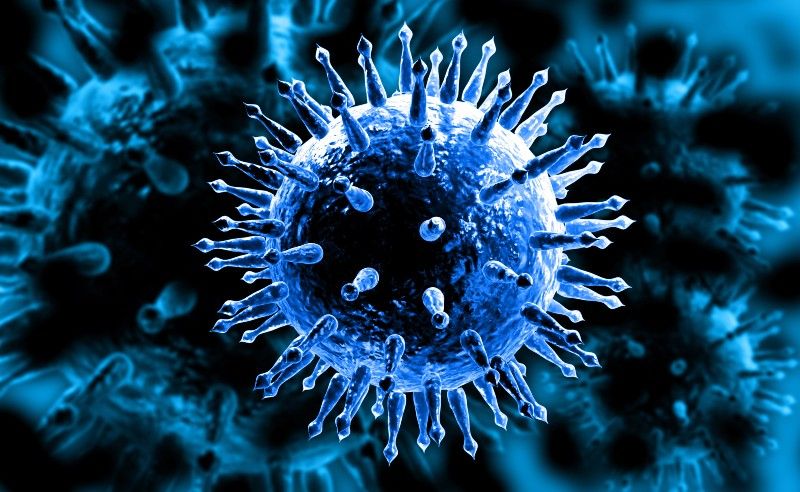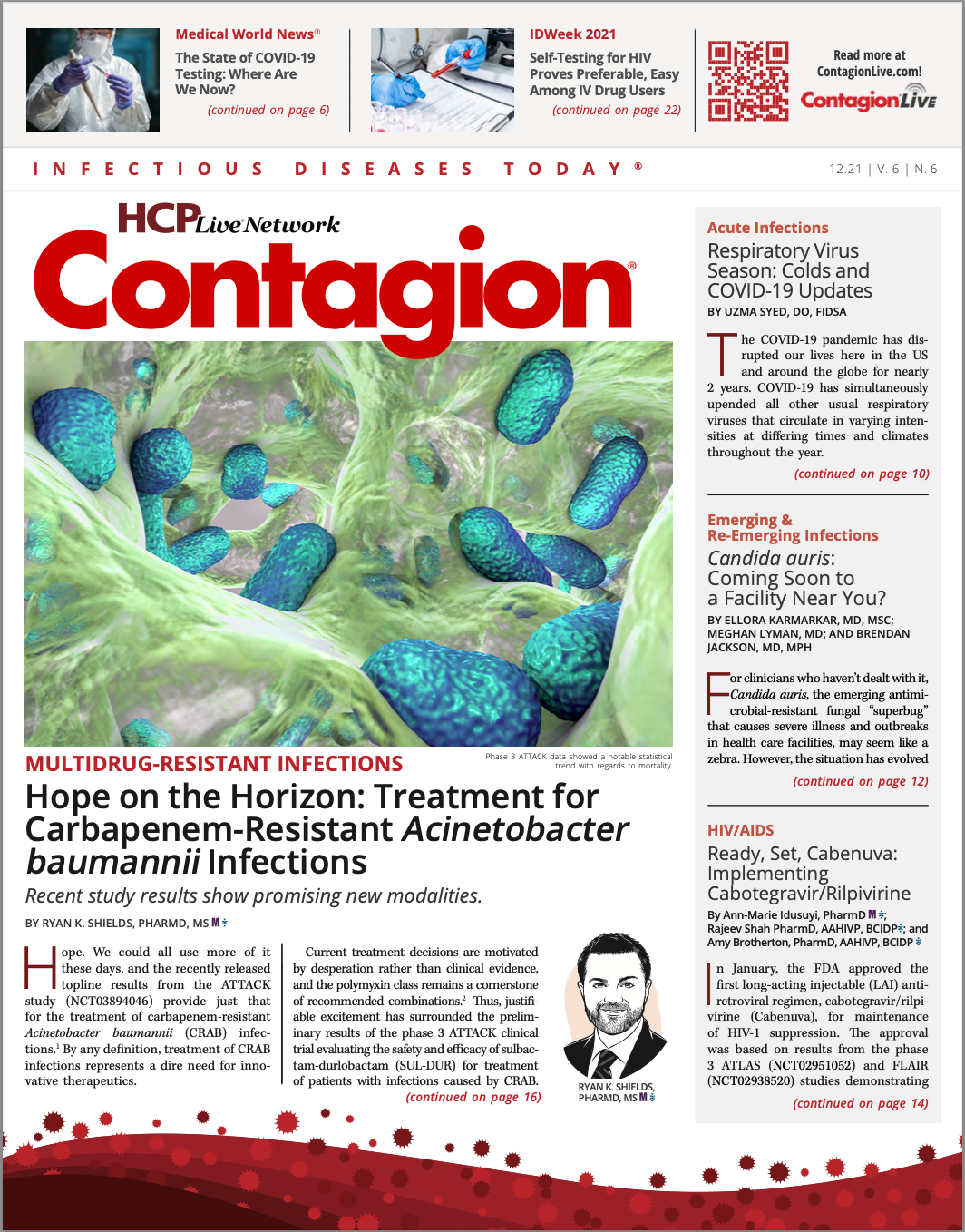Respiratory Virus Season: Colds and COVID-19 Update
Will this winter bring the feared twindemic of SARS-CoV-2 and influenza, or will another common infection reemerge?
Driven by the fear that a twindemic may completely collapse a struggling health care system and workforce, health care workers and medical experts urged people to get vaccinated for influenza (Adobe Stock).

The COVID-19 pandemic has disrupted our lives here in the US and around the globe for nearly 2 years. COVID-19 has simultaneously upended all other usual respiratory viruses that circulate in varying intensities at differing times and climates throughout the year.
SARS-CoV-2 has proven to be a formidable opponent for all other respiratory viruses. It has dominated the globe for more than a year and will likely continue to do so for some time.
Background
After the emergence of the SARS-CoV-2 virus and the resultant COVID-19 pandemic, the world saw firsthand the abrupt elimination of all other respiratory viruses. Many factors contributed to these trends. The high transmissibility and mortality from this novel virus eliminated other benign seasonal respiratory viruses from taking hold in communities. SARS-CoV-2 accomplished this by being the aggressive front-runner and, in turn, ending the life of its host, leaving fewer hosts to infect and thereby less propagation of other respiratory viral infections.
With the amount of strain on health care systems and the degree of morbidity and mortality from the COVID-19 pandemic seen on a global scale, fears of a parallel intense influenza season loomed for the northern hemisphere. With the highly fit SARS-CoV-2 virus, however, influenza activity remained extremely low even during the usual peak flu season.1 That along with good mitigation practices showed a compelling case for prevention of infection both in and out of health care systems.
Driven by the fear that a twindemic may completely collapse a struggling health care system and workforce, health care workers and medical experts urged people to get vaccinated for seasonal influenza. Vaccination for influenza serves as a measure to protect all individuals, including adults who are immunocompromised and children who may be susceptible to worse outcomes, and simultaneously promotes a strong and sustainable workforce during an ongoing pandemic.
As COVID-19 cases soared in winter of 2020 and the nation experienced record hospitalizations and death, the seasonal influenza activity was practically nonexistent. This trend was fortunate and also notable for other respiratory viruses including respiratory syncytial virus (RSV), parainfluenza, metapneumovirus, adenovirus, etc.2
Influenza vaccinations and good mitigation practices, along with the more competitive opponent of SARS-CoV-2, prevented many coinfections and a resultant twindemic. With immune-naïve people and no COVID-19 vaccine available, the nation was averaging approximately 300,000 cases a day.3 The third surge the nation experienced was one of the harshest ones—fueled by a more transmissible Alpha variant combined with easing in mitigation strategies, holiday travel, and pandemic fatigue.
Traditional seasonal respiratory viruses remained at low levels due to a combination of virtual schooling, continued domination by SARS-CoV-2, and other infection-prevention strategies.
Vaccinations and Respiratory Virus Trends
As vaccinations were being deployed across the country, we saw a successful decline in COVID-19 cases during spring and into early summer 2021. The light at the end of the tunnel was finally visible, and many Americans were rejoicing and claiming victory against the pandemic.
Easing of mitigation strategies such as masks led to increasing levels of activity of other respiratory viruses usually prominent during fall and winter season in the northern hemisphere. As socializing resumed across age groups, we saw increasing cases of RSV, parainfluenza, and human metapneumovirus in the summer months.2
Other respiratory viruses such as rhinoviruses reemerged internationally and nationally, despite masks, due to the inherent properties of the virus. Rhinoviruses lack an outer lipid layer, are more resistant to disinfectants, and can be viable on fomites for longer periods of time—accounting for more transmissibility in schools.4 Sharp increasing cases of rhinovirus can be correlated with the reopening of schools.
Declining Cases, Possibility of Low Levels of Virus
After a plateau in community transmission, the United States is experiencing a decline in COVID-19 infection rates and averaging approximately 75,000 new cases per day versus more than 300,000 cases per day at our highest peak.5 Although a stark improvement, rates are still higher in comparison to our lowest levels of daily case numbers, which were reported in June at roughly 11,000.6
With more than 190 million individuals who are fully vaccinated and vaccine mandates in place for industries, vaccinations can continue to provide reprieve from high levels of circulating virus in our communities.7 As we head into yet another pandemic winter—this time with vaccines on our side—we enter the next stage of the pandemic in hopes of better protection and fewer outbreaks, hospitalizations, and deaths.8
The Case for Surges of Other Respiratory Viruses
With declining cases comes the false sense of victory against COVID-19, which then leads to a decline in overall mitigation measures. Due to a lack of mask mandates in most of the country, resurgence of other respiratory viruses will likely be in addition to potential coinfection with SARS-CoV-2 and other respiratory viruses in areas with low vaccination rates. The regions where much of the population is unvaccinated and lacks natural immunity from prior infection will be the most affected, as evident from our summer surge.
The concern for coinfection is more worrisome due to potential worse outcomes in patients, more hospitalizations, and more strain on the health care workforce and hospitals. From all our prior experiences during the COVID-19 pandemic, it is clear that a strained health care system leads to worse outcomes for both patients and workers.9
Declining rates of routine vaccinations in the pediatric population coupled with nonexistent prior influenza activity can lead to a perfect storm and a worrisome flu season this year. With misinformation and disinformation campaigns leading to the current infodemic, the resistance to COVID-19 vaccines will have a ripple effect on many other routine immunizations, including influenza, and may have significant health consequences.10
The Answer Remains Unknown
Schools are fully open, and the pediatric population aged 5 to 11 years who account for 28 million of the US population, and for whom vaccines are now readily available, the majority are unvaccinated.11 Though vaccinations have begun for the pediatric population, how quickly and how much of this population will be vaccinated remains to be seen. The risk of coinfection with SARS-Cov-2 and seasonal respiratory infections is high. Study findings have shown that children—whether symptomatic or asymptomatic—can carry significant amounts of virus, leading to continued community transmission.12
Pediatric cases of COVID-19 were high during the summer surge and for the week of October 7, accounting for 24.8% of reported COVID-19.7 Vaccinations in children aged 12 to 17 years accounted for 5% of the US population (8,599,514) in those aged 12 to 15 years and 2.5% (4,799,654) of the US population in those aged 16 to 17 years (data based on age were available for 91% of people who were fully vaccinated).13
Concerns about vaccination of pediatric population exist, which can hinder our progress in the pandemic. A recent survey by the COVID-19 Vaccine Education and Equity Project and the National Association of School Nurses showed that two-thirds of parents with school-aged children (aged 5-11 years) plan to vaccinate their child.14
What will happen next in the pandemic is largely unknown. According to the The Institute for Health Metrics and Evaluation, the projected cases of COVID-19 will increase from December/January; however, the impact of this will depend on behavior patterns and vaccination rates. Global travel will keep new and emerging variants predominant. What lies ahead is rather unpredictable, as we have experienced firsthand during this pandemic.
Uzma Syed, DO, FIDSA, is a board-certified infectious disease specialist. She is a partner at South Shore Infectious Diseases, chair of the COVID-19 Task Force at Good Samaritan Hospital Medical Center, and the director of the Antimicrobial Stewardship Center of Excellence at Good Samaritan Hospital Medical Center. Syed is a fellow of the Infectious Diseases Society of America as well as member of their Inclusion, Diversity, Access & Equity Task Force. Syed has led several COVID-19 therapeutics clinical trials as the principal investigator.
References:
- When is flu season? CDC. Updated September 28, 2021. Accessed November 9, 2021. https://www.cdc.gov/flu/about/season/flu-season.htm
- Olson SJ, aWinn AK, Budd AP, et al. Changes in influenza and other respiratory virus activity during the COVID-19 pandemic. MMWR Morb Mortal Wkly Rep. 2021;70:1013-1019. doi:10.15585/mmwr.mm7029a1
- Villegas P, Noori Farzan A, Cunningham E, et al. U.S. surpasses 300,000 daily coronavirus cases, the second alarming record this week. Washington Post. January 8, 2021. Accessed November 9, 2021. https://www.washingtonpost.com/nation/2021/01/08/coronavirus-covid-live-updates-us/
- Wan WY, Thoon KC, Loo LH, et al. Trends in respiratory virus infections during the COVID-19 pandemic in Singapore, 2020. JAMA Netw Open. 2021;4(6):e2115973.doi:10.1001/jamanetworkopen.2021.15973
- COVID Data Tracker Weekly Review. CDC. Updated December 10, 2021. AccessedNovember 9, 2021 https://www.cdc.gov/coronavirus/2019-ncov/covid-data/covidview/index.html
- Coronavirus in the U.S.: Latest Map and Case Count. New York Times. Updated December 10, 2021. Accessed November 9, 2021. https://www.nytimes.com/interactive/2021/us/covid-cases.html
- COVID Vaccine Tracker. CDC. Accessed November 9, 2021. https://covid.cdc.gov/covid-data-tracker/#vaccinations_vacc-people-onedose-pop-12yr
- Coronavirus in the U.S.: latest map and case count. New York Times. November 9, 2021. Accessed November 9, 2021. https://www.nytimes.com/interactive/2021/us/covid-cases.html
- Wozniak, H., Benzakour, L., Moullec, G. et al. Mental health outcomes of ICU and non-ICU healthcare workers during the COVID-19 outbreak: a cross-sectional study. Ann Intensive Care. 2021;11(1):106. doi:10.1186/s13613-021-00900
- Pratt E. How vaccine hesitancy could impact flu season this year. Healthline. July 29, 2021. Accessed November 9, 2021. https://www.healthline.com/health-news/how-vaccine-hesitancy-could-impact-flu-season-this-year#Getting-a-flu-shot
- Hernandez J. The U.S. is ready to roll out the COVID vaccine once it’s approved for kids age 5-11. NPR. October 20, 2021. Accessed November 9, 2021. https://www.npr.org/sections/coronavirus-live-updates/2021/10/20/1047587933/covid-19-children-kids-vaccine-coronavirus?utm_campaign=politics&utm_source=twitter.com&utm_medium=social&utm_term=nprnews
- Yonker LM, Boucau J, Regan J, Choudhary MC. Virologic features of SARS-CoV-2 infection in children. J Infect Dis. Published online October 14, 2021. doi:10.1093/infdis/jiab509
- Children and COVID-19: state-level data report. American Academy of Pediatrics. Updated November 8, 2021, Accessed November 9, 2021. https://www.aap.org/en/pages/2019-novel-coronavirus-covid-19-infections/children-and-covid-19-state-level-data-report/
- New survey: two in three parents of children ages 5-11 plan to vaccinate their child against COVID-19. COVID-19 Vaccine Education and Equity Project. October 14, 2021. Accessed November 9, 2021. https://covidvaccineproject.org/news/parentpoll/

